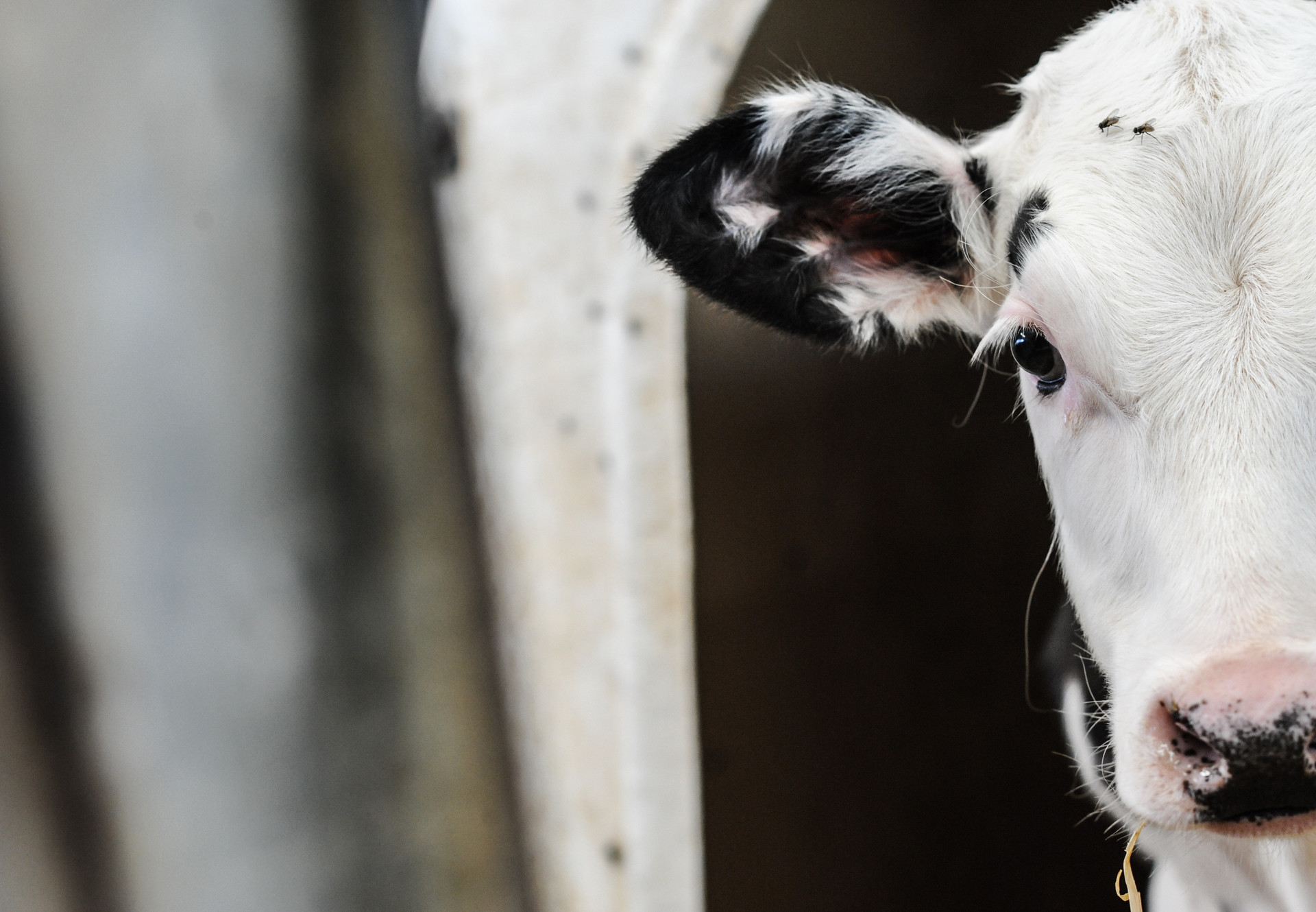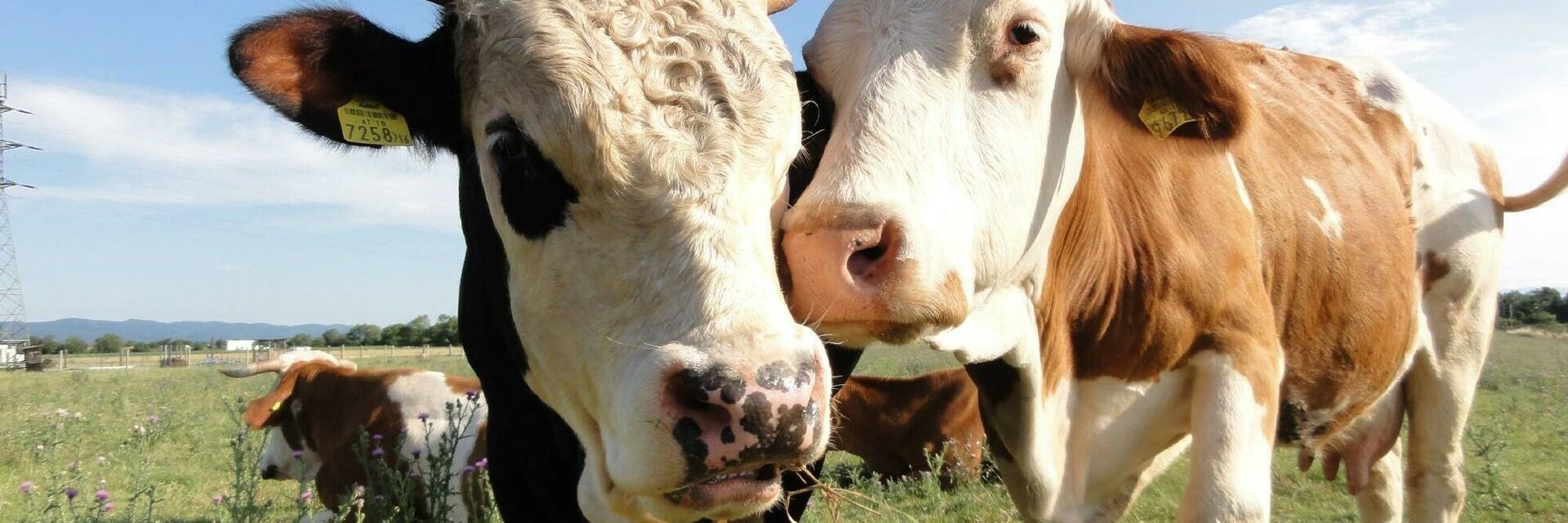
The Suffering of Calves
A distressing and sad youth for the by-products of the meat and dairy industry
Most of the calves are born in the dairy husbandry systems and are almost immediately separated from their mothers. They are not fed according to their needs and natural behaviour. Additionally, they are transported at a very young age (See more here) to veal- or other fattening systems, mixed with unfamiliar calves from other herds and then slaughtered. All that without ever experiencing their mother’s care. Female calves from dairy farms are raised to continue their life in the stressful cycle that is called the dairy production system.
Separation pain and force-feeding: The sad childhood/youth of calves
The task of a dairy cow is to produce a lot of milk. But she only gives milk, if she gives birth to a calf. The cow is artificially inseminated for the first time at the age of 16-18 months and then pregnant for nine months. Shortly after the birth of her first calf, the cow gives milk to be sold for (human) consumption. To sell as much milk as possible, the cow and calf are separated from each other after a few hours or days and the calf is then usually given a bought-in milk substitute - a mixture of skimmed milk powder and water and is usually kept in a single box for the first weeks and fed only twice a day with that substitute.
The separation from the mother often makes the calf more susceptible to illness. Usually calves feed 6-8 times a day on their mother's udders. By separating the cow and the calf, the calf has to drink the milk from a bucket, which only happens 2 times a day. The calves therefore drink hastily and consume large amounts at once. This, and the stressful events reducing their immune response, are giving many calves a life-threatening diarrhea, resulting in an average mortality rate for calves on dairy farms of 10% or more1.
When a cow and the calf are separated right after birth, there is no mother-child bond established. If they are allowed to stay together for a certain time, but still weaned too early, then this can lead to serious animal welfare relevant reactions. Due to lack of child-mother-contact, behavioural disorders can occur, such as cross suckling and navel suckling (due to a calf’s intrinsic need to suckle, the calf starts to suckle other structures in the pen and also eg. the navel of another calf). This is extremely painful for the suckled calf, as it can lead to inflammation. The animals deprived of suckling possibilities may show signs of extreme mental suffering, which can lead to physical impairment, e.g. serious loss of weight (emaciation).
Social Isolation: The young animals are also often very socially isolated
More than 60% of all European dairy calves are not only separated from their mothers almost immediately after birth, but also individually housed during their first eight weeks2. This is done to reduce the spread of possible diseases and to inhibit a specific behavioural disorders called cross-suckling. Calves housed individually are easier to catch, however it leaves them with less space and with no opportunities to engage in essential social behaviour. There have even been studies, showing that individually housed calves in fact can consume less solid feed and grow more slowly than group housed calves3.
Early social environment is absolutely critical for behavioural development and allows calves to establish and maintain social relationship (allo-grooming, locomotor play behaviour) which facilitate the development of essential skills and provide a foundation for social support4. Calves should therefore be housed in groups or at least pairs, and with enough space provided that they are able to express their natural play behaviour.
Drenching of calves/Stomach tubing
The first times the calf suckles at the udder of his mother takes some time, as both are unused to the procedure or might still be weak from the parturition. In industrial milk production, however, the animal owners often experience a shortage of time. The more animals a farmer has to take care of, the less time there is for an individual animal. In some countries, calves are therefore often “drenched” by livestock farmers on large farms immediately after birth, instead of waiting until the mother cow is suckling their offspring themselves. Drenching is a type of forced feeding in which a plastic tube is inserted through the mouth of the calf into the esophagus to provide it with the colostrum (the first milk from their mother’s udder) that is essential for life immunity in cattle. Colostrum contains immune bodies that the calf needs for a healthy immune system. The calves should be able to drink from their mother shortly after birth, because their guts can uptake immune bodies only for few hours into the blood. Drenching requires a lot of specialist knowledge. Farmers are still allowed to do it themselves, even though they are not specialised in it. Repeatedly, there are cases, in which the colostrum gets into the trachea instead of the esophagus. If the tube is pulled out before it is completely empty, the milk can also get into the windpipe. The calves often get pneumonia because of it or they can even suffocate. Drenching should therefore only be done by a veterinarian and only if it is a life-saving measure, because the calf does not drink from the mother's udders despite having sufficient time.
Mutilation
Painful interventions are carried out on calves without anaesthesia: dehorning, tail docking, branding/ear tagging, castration... the painful management procedures are generating fear, pain and distress, thus diminishing the immune system, altering brain function and the behaviour of the animals. While the physical pain ceases after some days or weeks, the behavioural changes last a lifetime. Learn more about it here.
Male dairy cow calves are worth nothing
The male calves of the milk breeds do not put on much meat during their youth and are therefore hardly worth anything on the meat market. Calves that are too lean for fattening or sick are often neglected. It is suspected that some farmers even let them die, if the veterinarian seems too expensive. Other male calves are sold to the veal industry in Holland, Belgium or Italy. There they are kept in dark, litter-free stalls to produce light colored veal. Roughage does not exist or is provided in too small quantities. Calves that do not survive the long transport of animals and are in poor health are put to sleep at the national borders.
Exact number of dead male calves is only available from the seventh day of life of the animals. From then on, they must wear an ear tag and be registered in the official database. Calves that die within the first week of life do not appear in any statistics. This makes it difficult to keep track of the calves' whereabouts.
FOUR PAWS calls for
...the end of cruel practices:
- Calves and their mothers (or nursing cows) should stay together for at least three months, giving them the ability to form a mother-child bond and prevent behavioural disorders and separation distress
- The young animals should not be kept in isolation
- No painful procedures should be permitted, but until that can be possible:
- Castration can only be practiced with the use of anaesthesia and analgesia, until the age of maximum of 42 days, by an experienced veterinarian and must also be followed by post-operative pain alleviations
- Calves should not be disbudded - herds should be kept horned or bred genetically hornless; until then, for all methods and ages at which disbudding is carried out, pain relief should be used
- Fulfillment of basic needs
Source
2) https://www.nature.com/articles/s41598-019-56798-w
3) https://www.sciencedirect.com/science/article/pii/S002203021000319X
4) https://www.nrcresearchpress.com/doi/abs/10.1139/cjas-2019-0031#.XtX5P8BCTIU
5) https://www.ndr.de/nachrichten/Die-Ramschkaelber,sendung514264.html




